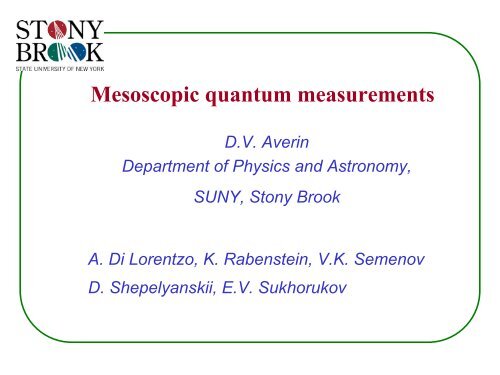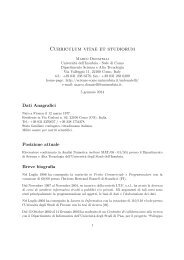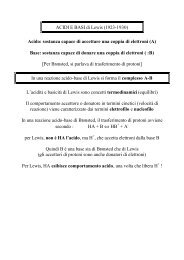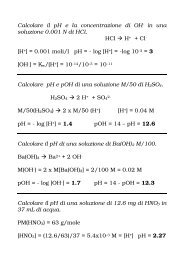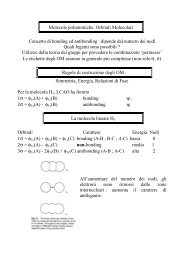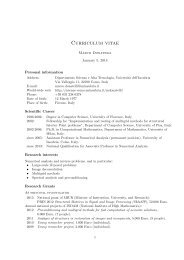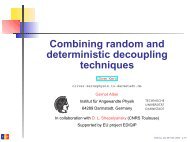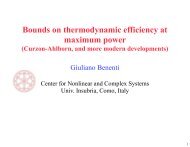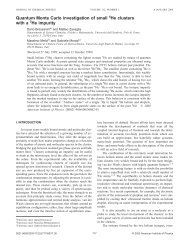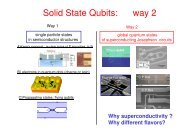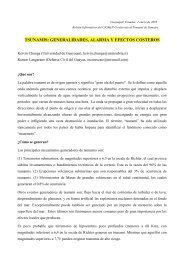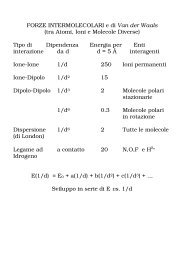Mesoscopic quantum measurements
Mesoscopic quantum measurements
Mesoscopic quantum measurements
Create successful ePaper yourself
Turn your PDF publications into a flip-book with our unique Google optimized e-Paper software.
<strong>Mesoscopic</strong> <strong>quantum</strong> <strong>measurements</strong><br />
D.V. Averin<br />
Department of Physics and Astronomy,<br />
SUNY, Stony Brook<br />
A. Di Lorentzo, K. Rabenstein, V.K. Semenov<br />
D. Shepelyanskii, E.V. Sukhorukov
Summary<br />
α 0 + β 1<br />
Example of the trivial wavefunction<br />
reduction:<br />
Basic understanding of <strong>quantum</strong><br />
<strong>measurements</strong>:<br />
the measurement process is<br />
``decoherence with an output’’;<br />
reduction of the wave-function is<br />
a classically trivial act of picking<br />
one random outcome out of several<br />
possibilities.<br />
``Quantum measurement<br />
problem’’: wave function is<br />
typically reduced in an unusual<br />
way, not compatible with the<br />
Schrödinger equation.
Outline<br />
1. Basics<br />
- superconductor and semiconductor single-charge qubits<br />
- QPC as a <strong>quantum</strong> detector<br />
- ideal <strong>quantum</strong> detectors: trade-off between information<br />
gain and back-action dephasing in <strong>quantum</strong> <strong>measurements</strong><br />
2. Dynamics of <strong>quantum</strong> <strong>measurements</strong><br />
- linear<br />
- quadratic
R.A. Millikan, Phys. Rev. (Ser. I)<br />
32, 349 (1911).
Quantum dynamics of Josephson<br />
junctions<br />
• Superconductor can be thought of as a BEC of Cooper pairs:<br />
one single-particle state<br />
Ψ =<br />
iϕ<br />
ne<br />
occupied with macroscopic number of particles. The phase φ<br />
and the number of particles n are conjugate <strong>quantum</strong> variables<br />
(Anderson, 64; Ivanchenko, Zil’berman, 65):<br />
[n,ϕ] =i.<br />
This relation describes dynamics of addition or removal of<br />
particles to/from the condensate.
• If <strong>quantum</strong> fluctuations of phase φ become large, junction<br />
behavior can be described as a semiclassical dynamics of charge<br />
that leads to controlled transfer of individual Cooper pairs<br />
(D.V. Averin, A.B. Zorin, and K.K. Likharev, 1985):<br />
H<br />
2<br />
= −E<br />
∂ / ∂ϕ<br />
− E cosϕ<br />
=<br />
=<br />
E<br />
C<br />
C<br />
( n − q)<br />
2<br />
2<br />
−<br />
E<br />
J<br />
J<br />
2(<br />
n<br />
n ± 1<br />
+<br />
n ± 1<br />
n<br />
),<br />
E C ≡ (2e)<br />
2<br />
2C<br />
.<br />
2<br />
1.0<br />
(a)<br />
E C<br />
/E J<br />
= 10<br />
(b)<br />
ε 0<br />
/E J<br />
1<br />
0<br />
6<br />
3<br />
1<br />
<br />
0.5<br />
−1<br />
0.5<br />
−0.5 −0.3 −0.1 0.1 0.3 0.5<br />
q=V g<br />
C/2e<br />
0.0<br />
0.0 0.2 0.4 0.6 0.8 1.0<br />
q
Cooper-pair box as charge qubit<br />
If a small Josephson junction is biased through a capacitor not<br />
resistor, one obtains configuration of a ``Cooper-pair box’’<br />
(M. Buttiker, 1987, H. Pothier et al., 1989) which avoids the problem of<br />
electromagnetic environment.<br />
For E J
Coherent oscillations in two coupled charge qubits<br />
a<br />
reservoir 2<br />
reservoir 1<br />
probe 2<br />
coupling<br />
island<br />
probe 1<br />
aI 2<br />
( pA)<br />
I 1<br />
(pA)<br />
4<br />
3<br />
13.4 GHz<br />
box 2 box 1<br />
dc gate 2<br />
pulse gate dc gate 1<br />
1µ<br />
m<br />
b E J2, CJ 2 E J1, CJ1<br />
C b2 C b1<br />
V b2 V b1<br />
C m<br />
C g2<br />
C p<br />
C C<br />
p<br />
g1<br />
V g2<br />
V g1<br />
V p<br />
b<br />
c<br />
I 1<br />
(pA)<br />
d<br />
I 2<br />
(pA)<br />
2<br />
5<br />
4<br />
3<br />
2<br />
1<br />
5<br />
4<br />
3<br />
2<br />
1<br />
0<br />
5<br />
4<br />
3<br />
2<br />
1<br />
0<br />
0.0 0.2 0.4 0.6 0.8 1.0<br />
∆t(ns)<br />
Yu. A. Pashkin et al., Nature 421, 823 (2003).<br />
9.1 GHz<br />
0 10 20 30<br />
f(GHz)
Oscillations of probability p j to have a Cooper on the box j=1,2:<br />
2 2<br />
2<br />
1 ⎡<br />
E<br />
1,2 2,1<br />
4<br />
⎤<br />
J<br />
− EJ<br />
+ Em<br />
p1 ,2(1)<br />
= ⎢1<br />
− cos( Ωt)cos(<br />
εt)<br />
−<br />
sin( Ωt)sin(<br />
εt)<br />
⎥,<br />
2 ⎣<br />
4Ωε<br />
⎦<br />
Ω =<br />
2 2 2<br />
( ∆ ) 1/<br />
,<br />
+ E m<br />
2 2 2<br />
( ) 1/<br />
,<br />
δ ∆ = ( E + E ) 2.<br />
ε = δ + E m<br />
= ( EJ<br />
2<br />
− EJ1) 2,<br />
1.0<br />
J1 J 2<br />
Entanglement between the qubits in the process<br />
of oscillations<br />
1<br />
E = 1−<br />
∑ p±<br />
log2 p±<br />
, p±<br />
= 1±<br />
1−<br />
r ,<br />
2<br />
±<br />
E<br />
0.5<br />
r<br />
= 1 2<br />
2<br />
4<br />
Em<br />
2 Em<br />
2 2Em<br />
2<br />
[ 1−<br />
sin ( Ωt)<br />
− sin ( εt)<br />
+ sin ( Ωt)sin<br />
2 ( εt)<br />
+<br />
2<br />
2<br />
2 2<br />
2 Ω<br />
ε<br />
Ω ε<br />
+<br />
∆<br />
2<br />
Ω<br />
2<br />
m<br />
4<br />
E<br />
sin<br />
4<br />
δ<br />
( Ωt)<br />
+<br />
ε<br />
2 2<br />
Em<br />
4<br />
sin<br />
4<br />
( εt)<br />
+<br />
2<br />
m<br />
E<br />
sin(2Ωt)sin(2εt<br />
2Ωε<br />
0.0<br />
)]<br />
0.0 5.0 10.0<br />
t∆/2π<br />
1/ 2<br />
.
Quantum-dot qubits<br />
J.M. Elzerman et al., PRB 767, 161308 (2003).
Quantum antidot qubits<br />
G j<br />
- control gates<br />
Ω- inter-QAD tunnel<br />
amplitude<br />
ε - quasiparticle<br />
"localization"<br />
energy<br />
• Information encoded in the position of a<br />
quasiparticle in the system of two antidots.<br />
• Adiabatic level-crossing dynamics can be used to<br />
transfer quasiparticles between the antidots.<br />
• Conditions of operation: T
Fractional Charge of Laughlin Quasiparticles<br />
V.J. Goldman and B. Su, 1995
Invariance of the quasiparticle charge<br />
V.J. Goldman et al., PRB 64, 085319 (01).
Antidot transport of the FQHE quasiparticles<br />
Antidot ``molecule’’ demonstrates coherent quasiparticle<br />
transport in the double-antidot system<br />
I.J.Maasilta and V.J. Goldman, PRL 84, 1776 (00).
Quantum point contacts (QPC)<br />
M. Field et al., PRL 70, 1311 (1993).<br />
E. Buks et al., Nature 391, 871 (1999).
<strong>Mesoscopic</strong> <strong>quantum</strong> <strong>measurements</strong> II<br />
D.V. Averin<br />
Department of Physics and Astronomy,<br />
SUNY, Stony Brook<br />
A. Di Lorentzo, K. Rabenstein, V.K. Semenov<br />
D. Shepelyanskii, E.V. Sukhorukov
Summary<br />
α 0 + β 1<br />
Example of the trivial wavefunction<br />
reduction:<br />
Basic understanding of <strong>quantum</strong><br />
<strong>measurements</strong>:<br />
the measurement process is<br />
``decoherence with an output’’;<br />
reduction of the wave-function is<br />
a classically trivial act of picking<br />
one random outcome out of several<br />
possibilities.<br />
``Quantum measurement<br />
problem’’: wave function is<br />
typically reduced in an unusual<br />
way, not compatible with the<br />
Schrödinger equation.
Outline<br />
1. Basics<br />
- superconductor and semiconductor single-charge qubits<br />
- QPC as a <strong>quantum</strong> detector<br />
- ideal <strong>quantum</strong> detectors: trade-off between information<br />
gain and back-action dephasing in <strong>quantum</strong> <strong>measurements</strong><br />
2. Dynamics of <strong>quantum</strong> <strong>measurements</strong><br />
- linear<br />
- quadratic
Counting statistics in mesoscopic electron transport<br />
(a)<br />
j<br />
I<br />
V<br />
(b)<br />
ε<br />
I<br />
U (x) j<br />
ε+eV<br />
Average current:<br />
Current noise:<br />
∑<br />
I = ( eV / 2πh)<br />
.<br />
k<br />
D k<br />
SI<br />
( 0) = ( eV / 2 πh<br />
) ∑ Dk<br />
(1 − Dk<br />
).<br />
k<br />
Full counting statistics:<br />
(one mode)<br />
P<br />
( N )<br />
n<br />
= C<br />
n<br />
N<br />
D<br />
n<br />
(1 − D)<br />
N −n<br />
,<br />
N = ( eV<br />
L.S. Levitov and G.B. Lesovik, 1993<br />
/ 2πh)<br />
t.
Counting statistics and detector properties of a QPC<br />
( α 0<br />
Detector-induced ``back-action’’<br />
dephasing of the qubit<br />
→ α 0<br />
+ β 1 ) ⊗ in<br />
→<br />
⊗ ( t0 R + r0<br />
L ) + β 1 ⊗ ( t1<br />
R + r1<br />
L<br />
)<br />
( qubit)<br />
ρ out Tr{<br />
R,<br />
L}<br />
ρout<br />
ρin → ρ out<br />
( qubit)<br />
∗ ∗ ∗ ∗<br />
12<br />
( 0 1 0 r1<br />
= ρ = α β → α β t t + r ) ≤ α β<br />
Finally, summing scattering processes of different electrons we<br />
obtain back-action dephasing rate by the QPC detector at T=0:<br />
∗<br />
Γ<br />
d<br />
= −( eV 2πh)ln<br />
| t1 t0<br />
+ r1<br />
r0<br />
∗<br />
∗<br />
| .<br />
The dephasing rate at finite temperature:<br />
[<br />
−1<br />
Γ = ∫ dε<br />
2πh)ln det(1 − f ( ε)<br />
+ f ( ε)<br />
S 0 S )].<br />
d<br />
( 1
Information acquisition rate is determined by distinguishability<br />
of the distributions P j (n) of the transferred charge in different<br />
qubit states:<br />
W<br />
⎛<br />
1/ 2<br />
(1/ )ln [ 0(<br />
) 1(<br />
)] ,<br />
⎟ ⎞<br />
= − t ⎜<br />
∑ P n P n<br />
⎝ n<br />
⎠<br />
The usual counting statistics result for the QPC gives<br />
and<br />
W<br />
∑<br />
n<br />
1/ 2<br />
( )<br />
N<br />
D D R R ,<br />
[ P 0(<br />
n)<br />
P1<br />
( n)]<br />
= 0 1 + 0 1<br />
)ln( ) = − eV 2πh<br />
D D + R R ≤ Γ .<br />
( 0 1 0 1 d<br />
We see that the QPC is an ideal <strong>quantum</strong> detector with W=Γ d’ if<br />
no information is contained in the phases of the scattering<br />
amplitudes:<br />
φ0 = φ1,<br />
φ j = arg( t j / rj<br />
).<br />
D.V.A. and E.V. Sukhorukov, 2005
An electronic Mach-Zehnder interferometer<br />
Y. Ji et al., Nature 422, 415 (2003).
Phase information can be utilized for measurement if the QPC is<br />
included in the electronic Mach-Zender interferometer:<br />
V<br />
j<br />
r j r’<br />
j<br />
χ<br />
’<br />
t j<br />
t j<br />
S<br />
m<br />
⎛<br />
⎜<br />
i<br />
⎜<br />
⎝<br />
−iχ<br />
Rm<br />
, Dm<br />
e<br />
=<br />
−iχ<br />
Dm<br />
, i Rm<br />
e<br />
⎞<br />
⎟ ⎟ ⎠<br />
The QPC can always be turned into an ideal detector by adjusting<br />
the scattering matrix S m of the second QPC of the interferometer.<br />
If all measurement information is in the phases of the scattering<br />
amplitudes:<br />
φ = φ −φ<br />
≠ , D = ,<br />
this happens if<br />
0 1 0 0 D1<br />
χ = ( φ −φ1) / 2, D m = Rm<br />
0 =<br />
1/ 2.
Conditional qubit evolution<br />
Since transmission and reflection of an electron are classical<br />
alternatives, evolution of the qubit density matrix can be<br />
conditioned on the particular outcome of scattering (following<br />
``<strong>quantum</strong>-trajectories’’ approach in <strong>quantum</strong> optics; or A.N. Korotkov, 1999,<br />
in solid-state context). Depending on whether electron is transmitted<br />
or reflected,<br />
| α |<br />
or<br />
2<br />
| α |<br />
2<br />
0<br />
0<br />
0<br />
D0<br />
| α | 0<br />
→<br />
2<br />
[| α | D + | β |<br />
0<br />
Important points:<br />
R0<br />
| α | 0<br />
→<br />
2<br />
[| α | R + | β |<br />
0<br />
2<br />
2<br />
0<br />
D<br />
1<br />
0<br />
]<br />
1/ 2<br />
]<br />
,<br />
1/ 2<br />
• the qubit does not decohere;<br />
0<br />
2<br />
2<br />
R<br />
1<br />
,<br />
αβ<br />
*<br />
αβ<br />
*<br />
0<br />
0<br />
1<br />
1<br />
*<br />
0t1<br />
t αβ 0<br />
→<br />
2<br />
[| α | D + | β |<br />
r<br />
→<br />
[| α |<br />
• probabilities to be in the states 0 and 1 change.<br />
0<br />
2<br />
0<br />
*<br />
1<br />
r<br />
R<br />
0<br />
*<br />
αβ<br />
*<br />
2<br />
0<br />
+ | β |<br />
2<br />
1<br />
D<br />
1<br />
1<br />
R<br />
1<br />
]<br />
1/ 2<br />
]<br />
1/ 2<br />
,<br />
.
Bell-type relation for mesoscopic tunneling<br />
One can devise a simple sequence of qubit transformations<br />
demonstrating that charge is indeed being transferred between the<br />
qubit states even if the tunneling amplitude is vanishing.<br />
Start with the state σ x =1. After transmission of an electron<br />
ψ<br />
=<br />
D 0 0 + D1<br />
1 [ D0<br />
+ D<br />
The sequence of two pulses, one creating tunneling for a period of<br />
time, and another changing the phase between the states 0,1:<br />
∫<br />
∫<br />
1<br />
]<br />
1/ 2<br />
∆( t)<br />
dt / h = π / 4, ε(<br />
t)<br />
dt / h = 2 tan D1<br />
/ D0<br />
−1<br />
.<br />
−π<br />
/ 2,<br />
returns the qubit to the initial σ x =1 state, i.e. we have a closed cycle<br />
which involves tunneling and transfer of charge at ∆=0. For any<br />
classical charge state, there is a probability p to find the state σ x =-1,<br />
p = min{ D0,<br />
D1}<br />
[ D0<br />
+ D<br />
1<br />
]<br />
1/ 2<br />
.
Ballistic Read-out for Flux Qubits<br />
(flux analog of the QPC detector)<br />
f =<br />
1<br />
∆T<br />
Qubit<br />
SFQ pulses Distributed Josephson Junction Voltmeter<br />
mv<br />
H = H 0 + σ z δU<br />
( x)<br />
+ + U ( x)<br />
2<br />
It is convenient to characterize the qubit-detector interaction by the scattering<br />
parameters t 0 ,t 1 ,r 0 ,r 1 .<br />
2
Quantum dynamics of a single fluxon<br />
A. Wallraff et al., Nature 425, 155 (2003).
Generic model of a mesoscopic detector<br />
Detector dynamics should exhibit macroscopically different trajectories (see,<br />
e.g., J.W. Lee et al., 2005) most of the actual mesoscopic detectors are<br />
based on tunneling.<br />
qubit 1 detector<br />
Detector Hamiltonian<br />
H = ( t[<br />
Mˆ<br />
] ξ + h.<br />
c.)<br />
+ Hex,<br />
|0> |1><br />
t<br />
where ξ creates excitations in the process of particle<br />
transfer between the detector reservoirs.<br />
∆ 1<br />
( n)<br />
& kl<br />
ρ<br />
1 2 2 ( n)<br />
* ( n−1)<br />
* ( n+<br />
1<br />
)( )<br />
)<br />
+ + Γ−<br />
tk<br />
+ tl<br />
ρkl<br />
+ Γ+<br />
tktl<br />
ρij<br />
+ Γ−t<br />
ktl<br />
ρkl<br />
= − ( Γ<br />
2<br />
Γ<br />
+<br />
=<br />
∫<br />
dt ξ(<br />
t)<br />
ξ<br />
+<br />
,<br />
Γ<br />
−<br />
=<br />
∫<br />
+<br />
dt ξ ( t)<br />
ξ .<br />
Ensemble-averaged evolution Conditional evolution<br />
,<br />
ρ&<br />
γ<br />
kl<br />
kl<br />
= −γ<br />
kl<br />
1<br />
= ( Γ<br />
2<br />
ρ<br />
+<br />
kl<br />
+ Γ<br />
− i[<br />
H,<br />
ρ]<br />
−<br />
) t<br />
k<br />
− t<br />
j<br />
kl<br />
,<br />
2<br />
.<br />
ρ<br />
( n)<br />
kl<br />
( τ )<br />
= ρ (0)( Γ<br />
kl<br />
exp{ −(1/<br />
2)( Γ<br />
+<br />
+<br />
/ Γ<br />
−<br />
+ Γ<br />
)<br />
−<br />
n/ 2<br />
)( t<br />
k<br />
I<br />
n<br />
2<br />
(2t<br />
+<br />
t<br />
k<br />
l<br />
t<br />
l<br />
2<br />
Γ<br />
+<br />
Γ<br />
−<br />
) − inϕ<br />
)<br />
kl<br />
}.
Linear <strong>quantum</strong> <strong>measurements</strong><br />
Linear-response theory enables one to develop quantitative<br />
description of the <strong>quantum</strong> measurement process with an arbitrary<br />
detector provided that it satisfies some general conditions:<br />
• the detector/system coupling is weak so that the detector’s<br />
response is linear;<br />
• the detector is in the stationary state;<br />
• the response is instantaneous.<br />
H<br />
=<br />
H S + H D +<br />
xf<br />
D.V.A., cond-mat/00044364,<br />
cond-mat/0301524.<br />
S.Pilgram and M. Büttiker,<br />
PRL 89, 200401 (2002).<br />
A.A. Clerk, S.M. Girvin, and<br />
A.D.Stone, PRB, (2003).
Information/back-action trade-off in linear<br />
<strong>measurements</strong><br />
Dynamics of the measurement process consists of information<br />
acquisition by the detector and back-action dephasing of the<br />
measured system. The trade-off between them has the simplest form<br />
for <strong>measurements</strong> of the static system with H S =0. If x|j>=x j |j>, we<br />
have for the back-action dephasing:<br />
d<br />
ρ t)<br />
= ρ (0) e , Γ = π ( x − x ) S h .<br />
jj'<br />
( jj'<br />
−Γ<br />
t<br />
Information acquisition by the detector is the process of<br />
distinguishing different levels of the output signal =λx j in the<br />
presence of output noise S q . The signal level (and the corresponding<br />
eigenstates of x) can be distinguished on the time scale given by the<br />
by the measurement time τ m :<br />
2<br />
τ = 8πS<br />
[ λ(<br />
x − x )] , τ Γ = 8( π hλ)<br />
S S ≥ 1 2.<br />
m<br />
q<br />
j<br />
j'<br />
m<br />
d<br />
d<br />
j<br />
j'<br />
2<br />
2<br />
q<br />
f<br />
f<br />
2
FDT analog for linear <strong>quantum</strong> <strong>measurements</strong><br />
h λ ≤ 4π<br />
[ S<br />
f<br />
S<br />
q<br />
−<br />
(Re S<br />
fq<br />
)<br />
2<br />
]<br />
1/ 2<br />
,<br />
where λ is the linear response coefficient of the detector, S f and S q<br />
are the low-frequency spectral densities of the, respectively, backaction<br />
and output noise, ReS fq is the classical part of their crosscorrelator.<br />
As one can see, this inequality characterizes the efficiency of the<br />
trade-off between the information acquisition by the detector and<br />
back-action dephasing of the measured system. The detector that<br />
satisfies this inequality as equality is ``ideal’’ or ``<strong>quantum</strong>limited’’.
Continuous monitoring of the MQC oscillations<br />
The trade-off between the information acquisition by the detector<br />
and back-action dephasing manifests itself in the directly<br />
measurable quantity in the case of measurement of coherent<br />
<strong>quantum</strong> oscillations in a qubit.<br />
H = −<br />
∆ σ + σ f +<br />
2<br />
x<br />
z<br />
H<br />
D<br />
Spectral density S o (ω) of the detector output reflects coherent<br />
<strong>quantum</strong> oscillations of the measured qubit:<br />
S o ( ω)<br />
= S q<br />
+<br />
Γ<br />
d<br />
λ<br />
4π<br />
2<br />
( ω<br />
The height of the oscillation peak in the output spectrum is limited<br />
by the link between the information and dephasing:<br />
2<br />
− ∆<br />
Smax S q ≤ 4.<br />
2<br />
∆<br />
)<br />
2<br />
2<br />
+ Γ<br />
2<br />
d<br />
ω<br />
2<br />
.
12<br />
12<br />
ε=0.7∆<br />
S o<br />
/S q<br />
8<br />
Γ=0.1∆<br />
S o<br />
/S q<br />
8<br />
Γ/∆= 1.5<br />
1.0<br />
4<br />
4<br />
0.7<br />
Ω/∆=1.0 1.5 2.0<br />
0.3<br />
0<br />
0 1 2<br />
ω/∆<br />
0<br />
0.1 0.03<br />
0 1 2<br />
ω/∆<br />
A.N.Korotkov and D.V.A.,<br />
Phys. Rev. B 64, 165310 (2001).
Experimental continuous monitoring of the Rabi<br />
oscillations<br />
M<br />
L L T C T<br />
S V,max<br />
/S 0<br />
1<br />
0.5<br />
(a)<br />
a<br />
b<br />
c<br />
ω R<br />
/ω T<br />
1.1<br />
1<br />
(b)<br />
a<br />
b<br />
c<br />
E.Il’ichev et al.,PRL 91,<br />
097906 (2003).<br />
0<br />
0.96 0.98 1 1.02 1.04<br />
(P/P 0<br />
) 1/2<br />
0.9<br />
0.96 0.98 1 1.02 1.04<br />
(P/P 0<br />
) 1/2
Quadratic <strong>measurements</strong><br />
t [ Mˆ<br />
] = t + c Mˆ<br />
+ c<br />
ˆ<br />
2<br />
0 1 2M<br />
,<br />
Example: DC SQUID<br />
Mˆ<br />
1<br />
(1)<br />
z<br />
= λ σ + λ σ<br />
2<br />
(2)<br />
z<br />
t(<br />
Mˆ<br />
)<br />
= t<br />
(1) (2) (1) (2)<br />
0 + δ 1σ<br />
z + δ 2σ<br />
z + λσ z σ z<br />
Purely quadratic <strong>measurements</strong>, δ j =0.<br />
H 0 = 0<br />
.<br />
Quadratic measurement distinguishes ``parallel’’ from the ``antiparallel’’<br />
qubit state, i,.e., is the measurement of the product operator<br />
of the two qubits σ z<br />
(1)<br />
σ z<br />
(2)<br />
.<br />
The measurement time is<br />
τ<br />
S<br />
I<br />
m<br />
0<br />
a<br />
=<br />
S<br />
= ( Γ<br />
= ( I<br />
0<br />
+<br />
↑↑<br />
/ I<br />
2<br />
a<br />
,<br />
+ Γ<br />
− I<br />
−<br />
)(| t<br />
↑↓<br />
0<br />
|<br />
2<br />
+ | λ |<br />
) / 2 = ( Γ<br />
+<br />
2<br />
),<br />
0<br />
*<br />
*<br />
0<br />
− Γ )( t λ + t λ).<br />
−<br />
t(<br />
Φ)<br />
=<br />
E J<br />
2<br />
(1 −π<br />
Φ<br />
Φ
∑<br />
H0 = −∆ 2 σ x<br />
j<br />
( j)<br />
In this case, quadratic <strong>measurements</strong> can entangle two non-interacting symmetric<br />
qubits. Indeed, there are three possible measurement outcomes. In the first two,<br />
the qubits are entangled:<br />
I<br />
I<br />
I<br />
I<br />
0<br />
= I<br />
= I<br />
= I<br />
0<br />
0<br />
0<br />
+ I<br />
− I<br />
,<br />
λ<br />
λ<br />
= ( Γ+ − Γ−<br />
)(| t<br />
,<br />
,<br />
ψ ∈<br />
ψ = ↑↑ − ↓↓ ,<br />
ψ<br />
{ ↑↑ + ↓↓ , ↑↓ + ↓↑ },<br />
0<br />
|<br />
2<br />
=<br />
↑↓<br />
+ | λ |<br />
−<br />
2<br />
).<br />
↓↑<br />
,<br />
In the third outcome, the qubits perform coherent qubit oscillations at frequency<br />
that is twice the oscillation frequency of individual qubits.<br />
S<br />
I<br />
( ω)<br />
=<br />
S<br />
0<br />
+<br />
( ω<br />
2<br />
γ =<br />
8I<br />
− 4∆<br />
a<br />
2<br />
2( Γ<br />
∆<br />
)<br />
2<br />
2<br />
γ<br />
+ γ<br />
+ + Γ−<br />
2<br />
ω<br />
) λ<br />
2<br />
2<br />
.<br />
,<br />
W. Mao et al., PRL 93, 056803 (04)
Continuously-measured spectroscopy of two qubits<br />
Non-linear <strong>measurements</strong>,<br />
δ j ≠0, λ≠0.<br />
(1) (2)<br />
0 −∆<br />
σ z<br />
j<br />
S I<br />
/S 0<br />
t = t0 + 2δS z + λ(2Sz<br />
−1).<br />
2<br />
2 I jγ<br />
j<br />
w ≈ j∆,<br />
SI<br />
( ω)<br />
= S0<br />
+<br />
,<br />
2 2<br />
3 ( ω − j∆)<br />
+ γ j<br />
2 2<br />
γ 1 = ( Γ+<br />
+ Γ−<br />
)(| δ | + | λ | / 2), γ 2 = 2γ<br />
1,<br />
I1<br />
= ( I↑↑<br />
− I↓↓) / 2, I2<br />
= ( I↑↑<br />
+ I↓↓<br />
− 2I↓↑) / 2.<br />
I = ( I↑↑ + I↓↓<br />
+ I↓↑ ) / 3<br />
( j)<br />
H = 2∑ σ x + ( ν 2) σ z .<br />
2<br />
S I<br />
/S 0<br />
12<br />
8<br />
4<br />
0<br />
8<br />
4<br />
ν/∆=0.0<br />
1.0<br />
0.1<br />
0.2<br />
0<br />
0 1 2<br />
W. Mao et al., PRB 71, 085320 (05)<br />
ω/∆<br />
(a)<br />
(b)


